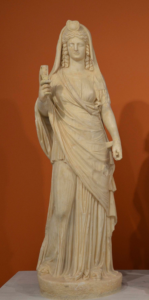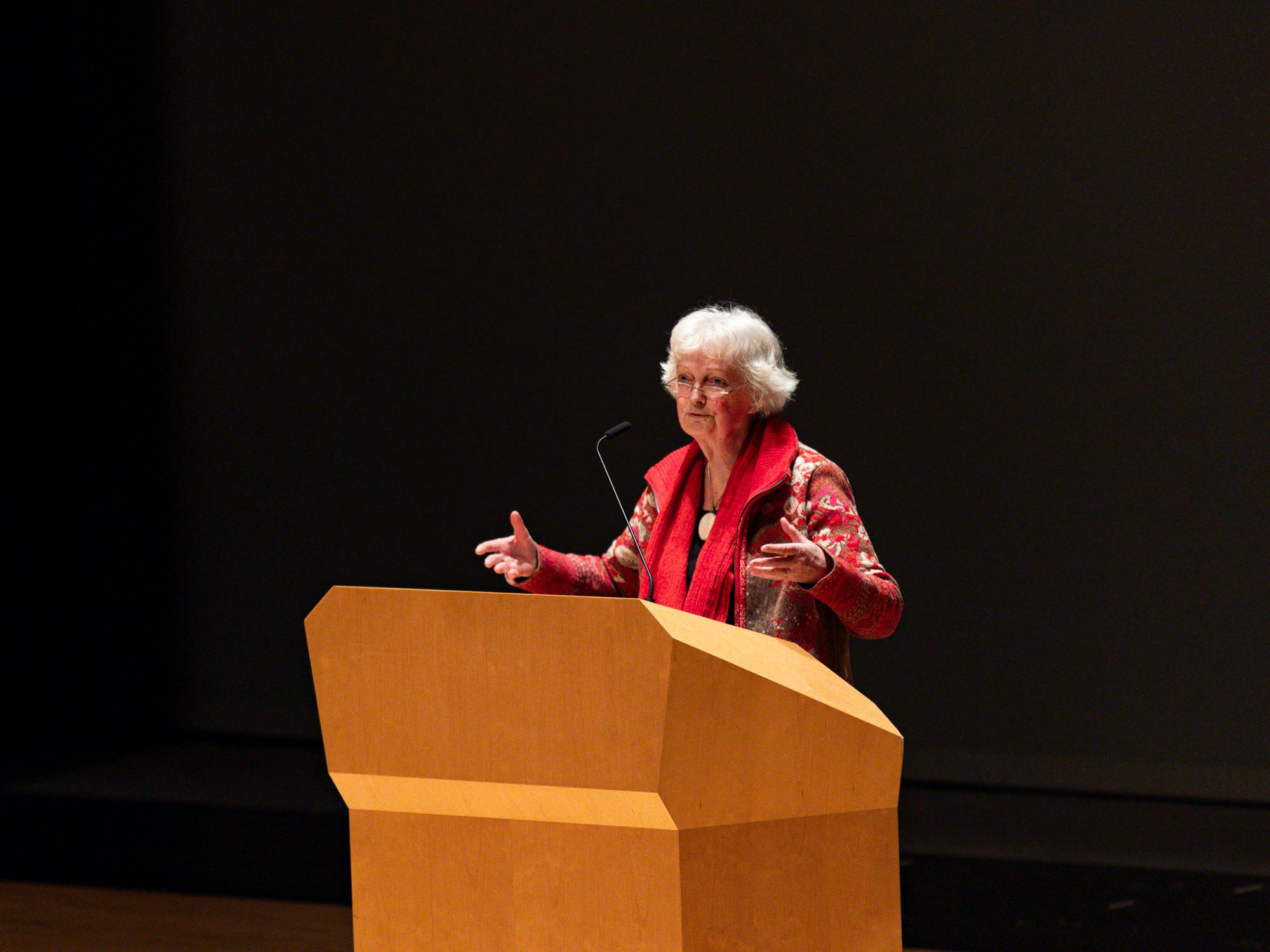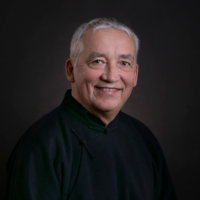Edith Lammerts van Bueren has researched the development over time of the mythological figure Persephone and her significance in Greek mythology, the School of Chartres, and Rudolf Steiner’s Mystery of the Logos lecture, in which Persephone, in the spirit of Christ, orchestrates the harmonious relationship of the plant world with the Earth and Cosmos. Here are excerpts from van Bueren’s talk at this year’s Agriculture Conference in Dornach.
How did I become aware of my connection with Persephone? About six years ago, I attended a party for a colleague in the seed business that began with a small symposium on seed production. Unexpectedly, the atmosphere turned grim, at least for me, as someone in the audience exclaimed angrily that it was irresponsible of the organic sector to reject genetic engineering. “The world is starving – we must use all resources at our disposal.” That night, it hit me hard – I started to doubt whether my life’s work had any impact at all. I discussed it with a good friend and cried out in desperation: For heaven’s sake, for whom am I doing all this? To my surprise, my friend took that question seriously and said, yes, for whom are you doing it? Is it Demeter? Is it Gaia? I thought, well, that’s close, but not quite. But I found that question: “In whose spiritual sphere am I working?” intriguing. Knowing whose spiritual sphere you are in helps you find direction and coherence in your daily endeavors. After meditating and living with this question for some days, the name Persephone revealed itself to me, and I knew immediately, no doubt, that is her. But what does that mean for me? Who is she? And so I began my spiritual research by reading what others have said, meditating on images and inspirations I received, and exchanging with others.
In Greek Mythology
From the Homeric Hymn to Demeter, some 800 years before Christ, we learn that Persephone is the goddess and guardian of the life forces on earth and specifically in the plant world. Demeter, her mother, watched over her very carefully. Persephone was allowed to call upon any god except Eros, the God of love, and to pick any flower except the daffodil. But Persephone could not resist. She called upon Eros, who seduced her to pick the most beautiful flower on earth, the daffodil. As soon as she did, the earth opened up, and mighty Hades, God of the realm of the dead, abducted her to the Underworld. When Demeter heard this, she was furious. The Underworld was the only place she did not have access to. In her grief, she neglected the earth, and the crops started to wither. She found the son of a local king, Triptolemos, who could descend to the Underworld and find Persephone. This forced Zeus, king of Olympus, to agree on a compromise: every year from now on, Persephone will be Hades’ spouse in the Underworld for autumn and winter, and in spring, she will be allowed to return to the upper world. Out of gratitude, Demeter and Persephone gifted Triptolemus with the art of arable farming.
In the School of Chartres
There is another image, centuries later, from the books of the early medieval teachers of the School of Chartres in France. Here, Persephone appears as Natura, the divine creative force in nature. At the School of Chartres, Persephone Natura explicitly relates to Christianity, which does not usually recognize spiritual beings such as Natura. However, Our Lady’s Cathedral at Chartres was built where a temple of the Celtic druids had once stood. These Celtic druids had a clairvoyant consciousness of Christ, the Logos, and they worshipped the Holy Virgin who will give birth once (Virgo paritura.) How wonderful that on the same hill, centuries later, the spirit of the Celtic nature religion would merge so well with Christianity, in the School of Chartres.
Persephone Natura was concerned because humans were drifting away from nature. She appeared to the famous Chartres teacher, Alanus ab Insulis, in a dream, which he recorded in The Anticlaudian. In it, she complained that nature cannot be saved if human actions are not imbued with the highest wisdom. She convened a heavenly council with the other Goddesses, and they agreed there had to be a new human. Sophia, the Goddess of cosmic wisdom, represented the Goddesses and traveled along all the planets until she arrived at the Trinity. She presented their request, whereupon God conceived a new human. Sophia received that human and gave it to Natura to provide it with a perfect body: the Christ being, whose earthly birth was accompanied on the one hand by Sophia Maria and on the other hand by Persephone Natura as the Celtic being of Saint Bride.
In Anthroposophy
Steiner refers in many of his lectures to the abduction of Persephone as the image of humanity’s early clairvoyance, which was stolen and disappeared into the subconscious. But he also said that those abilities do not simply disappear – they can return, metamorphosed. In the image of Persephone that Rudolf Steiner gave in the last year of his life, at Christmas 1924, in The Mystery of the Logos, Steiner places Persephone in a new relation to Christ.1
First, he describes how, during its development, humanity increasingly turns away from the cosmos and focuses on earthly phenomena to acquire an independent capacity for judgment based on self-awareness. The divine world allows this by withdrawing. In that process, a time comes when the connection between Earth and Cosmos has to become possible again. Therefore, the highest sun being has to descend to the earth to connect with the destiny of humanity and Earth and to overcome earthly death out of love for humanity and Earth. That is what Steiner refers to as the Mystery of Golgotha.
Steiner emphasises that the Golgotha Mystery is a one-time event in the development of humankind and that Persephone makes a similar gesture for the plant world, but in a yearly rhythm, because rhythm is the key to plant development. So, she too descends from the sun to the earth as a highly exalted being and connects the plants with their cosmic origin. Persephone’s mission is to bring the plant world back to its original orientation between the Cosmos and Earth.

Persephone and the Field Preparations
Two years after discovering my connection to Persephone, I was asked to teach phenomenology in a Waldorf teachers’ course. I decided to use my early research on biodynamic preparations as an example. (When I started at the Louis Bolk Institute, I did many years of field research with farmers on lettuce to compare treatment with and without biodynamic preparations.)
Back then, in the 50s to 70s, research on the performance of the spray or field preparations only looked at differences in treated and non-treated crops at harvest time. Sometimes the yield increased; sometimes, there was no difference; and sometimes the yield decreased, and this caused confusion. I thought perhaps we were not observing through the right lens. In the mid-80s, I learned from Jochen Bockemühl [former leader of the Natural Science Section] and Goethean Science that we should focus our attention on the growth dynamics during crop development and not merely on the end product. To this end, I used Goethean phenomenology in weekly crop observations to see what differences in growth dynamics revealed themselves through time and space. I also left a few rows of lettuce unharvested to continue flowering as an expression of the potential life forces present in the harvested crop.
I found that I always experienced the spray preparations as harmonizing, whatever the growing conditions. When the vegetative spring tendency was too strong, few plants could develop to flower and seed set. With the preparations, growth was held back a little bit, and most of the plants came to full development. When the growth impulse was too weak, for instance, during a very cold spring, the preparations clearly stimulated growth. In all cases, I experienced the preparations worked towards better lettuce-typical quality, for instance, in taste, enabling the full plant potential to express itself.
At that time, I did not associate the preparations with Persephone. It wasn’t until I was preparing my lesson on phenomenology 33 years later that it touched me that one preparation is buried in the winter and the other in the summer. I discovered, to my great joy, that the biodynamic field preparations are pre-eminently instruments of Persephone.
The cow dung, as a metabolic product, has a summer quality. It is stuffed in the cow horn and buried in winter, infusing it with winter forces. The horn silica preparation is based on hard crystalline rock, representing winter quality, and is buried in summer, infusing it with summer forces. The substances in the preparations are natural, but this integration of seasonal qualities is beyond-natural. It comes from the cosmic insights of Rudolf Steiner and lifts the plant up. Suddenly, I saw it: the field preparations are each other’s polarity but also carry the polarity in themselves. No other being has integrated these polarties into her essential being as Persephone has.
What a wonderful image! Realizing this, I understood better the imagination in the form of a cross that I had shortly before preparing that lesson, which puzzled me at that time. In a meditation, a cross with Christ appeared, and I heard, “Mind you, it is about the cross.” Christ slowly disappeared, but the cross remained. It’s not just about simply combining plant, mineral, and animal substances, nor is it about the natural rhythmic change of seasons to which the preparations are exposed – it is about the integration of these forces through the actions of farmers. In the integration of summer and winter forces, I experienced the image of the cross: the summer forces which allow the plants to spread out in time as the horizontal principle, and the winter forces through which the spiritual impulse works into the earth, as the vertical principle, both working at the same time. It’s precisely this integration of seasonal forces that is Persephone’s field of work: to reconnect the earthly plants with their cosmic origin.
One Step Further
In midwinter, we commemorate how the high spiritual Sun Being, out of love, connected himself with the fate of earth and humanity and brought light into the dark earth. Through coming to earth, Christ connected with the earth, and the soul forces of the earth were christianized. Because these soul forces are breathed in during winter, every year in December, people can experience this connecting power of Christ. Without that act of love, no connection between Earth and Cosmos would be possible – not for humanity and not for the plant world.
So Persephone, who is so connected with the birth of Christ, is working in the midwinter earth, in the sphere of Christ. This renewed connection between Earth and Cosmos, realized by the Christ being, is exactly the field in which Persephone works to bring back the plants to their original orientation with their cosmic origin.
Persephone and the Elemental Beings
If the preparations impact plant growth, they also impact the work of the elemental beings connected to plant development. These elemental beings are Persephone’s helpers, and they depend on moral guidance from higher beings and, increasingly, from us, from humankind. If we can see the biodynamic preparations as preeminent instruments of Persephone, then we can also understand that the field preparations give nourishment and new direction to the elemental beings. New because the preparations do something that does not occur in nature but is human-made to integrate earthly and cosmic forces.
In Man as Symphony of Creative Worlds, Rudolf Steiner describes how the gnomes push the sprouting plants upwards and how the sylphs pull the plants out of the ground from the cosmos.2 In the same terms, he describes the actions of the two field preparations – the horn manure preparation pushes up from below, and the horn silica preparation pulls up from above, not too weakly and not too strongly. In the latter aspect, I recognize the harmonizing effect of the preparations on the plant development that I saw in my lettuce research.
I think it’s timely and important that we learn to include the elemental beings in our consciousness. In my experience of working with biodynamic farmers, they can learn to connect and collaborate with them in agriculture through meditative attention, asking: What is needed on the farm or in a specific field? How can we help? And then be aware of what hints they whisper to us. They [the farmers] can open up their senses to understand the language of the elemental beings: for some in words, some in sounds, or colors and images.
Faith, Love and Hope
In the course of time, we as humans have become not only detached from the spiritual world and from nature but also from each other. I encounter this in my current field of research in plant breeding, where the business model is increasingly based on gene technology and patents to own seeds. Seeds! Part of our natural resources, our common good! IFOAM, our world umbrella organisation for organic agricultural movements, addresses this socio-economic aspect as “the principle of fairness,” and I’m convinced that there will be no ecological resilience without social resilience. Being detached from each other requires new connections, true relationships and new fellowship instead of out-competing each other to maintain a market share. Not an easy path.
But how does this connect to Persephone? I got a hint through a small book, Eleusis: Göttermythos und Einweihungsweg [Eleusis: myth of the gods and path of initiation, 1982] by Wolfgang Greiner. He discusses Persephone’s future quest in the Persephone myth. What will she do when she returns to the upper world? He points to Steiner’s second mystery drama, The Soul’s Probation, in which the modern path of initiation is pictured. In it, the future forces that connect the human soul to the cosmos appear as three beings: Philia, Astrid, and Luna. Steiner calls them the true daughters of Demeter, who were stolen but returned transformed to give humans faith, love, and hope in the next 5,000 years. It intrigues me that the Dutch doctor Ita Wegman was also searching for the future Persephone. In 1930, she wrote a drama with Walter Johannes Stein called Persephoneia Spiel [Persephone play]. It has never been performed, but the full text of that drama and the holy drama of Eleusis were recently published by Johannes Greiner [2021.] He compares the two dramas of Persephone. The holy drama of Eleusis tells how humankind went from ancient dreamy clairvoyance to self-consciousness, and the Persephoneia Spiel tells about the path we will go from self-consciousness to the new fellowship. There is no Demeter, no Zeus, no Triptolemus to rescue Persephone from the Underworld – she has to do it herself as a free, self-conscious individuality, but not alone: with a new community.
For me, faith is the trust in the spiritual world permeating the earthly world and that it can be researched by meditation in order to connect Earth and Cosmos. In the resurrection of Persephone, I trust that we can transform our materialistic dead thinking into living thinking, regarding the earth and the plants as living organisms, and including elemental beings and higher spiritual beings in our work with the earth. Love, I see as the new fellowship in new socio-economic forms, such as those emerging in initiatives like community-supported agriculture and other organic food networks. And, for me, hope is the driving force for us humans to remain steadfast in this immensely complex world and to look for new creative forms of reconnecting with the spiritual world, with nature, and with each other. And in doing so, we become helpers in Persephone’s mission.
More Edith’s book in Dutch is now available in German, Leben mit Persephone und die Zukunft der Pflanzenwelt [Living with Persephone and the future of the plant world], thanks to the efforts of the Goetheanum Verlag.
Title image Edith Lammerts van Bueren, Photo: Xue Li
Footnotes
- Rudolf Steiner, The Michael Mystery, “A Christmas Contemplation: the Mystery of the Logos”, CW 26.
- Rudolf Steiner, Man as Symphony of Creative Worlds, 1923, CW 230.





